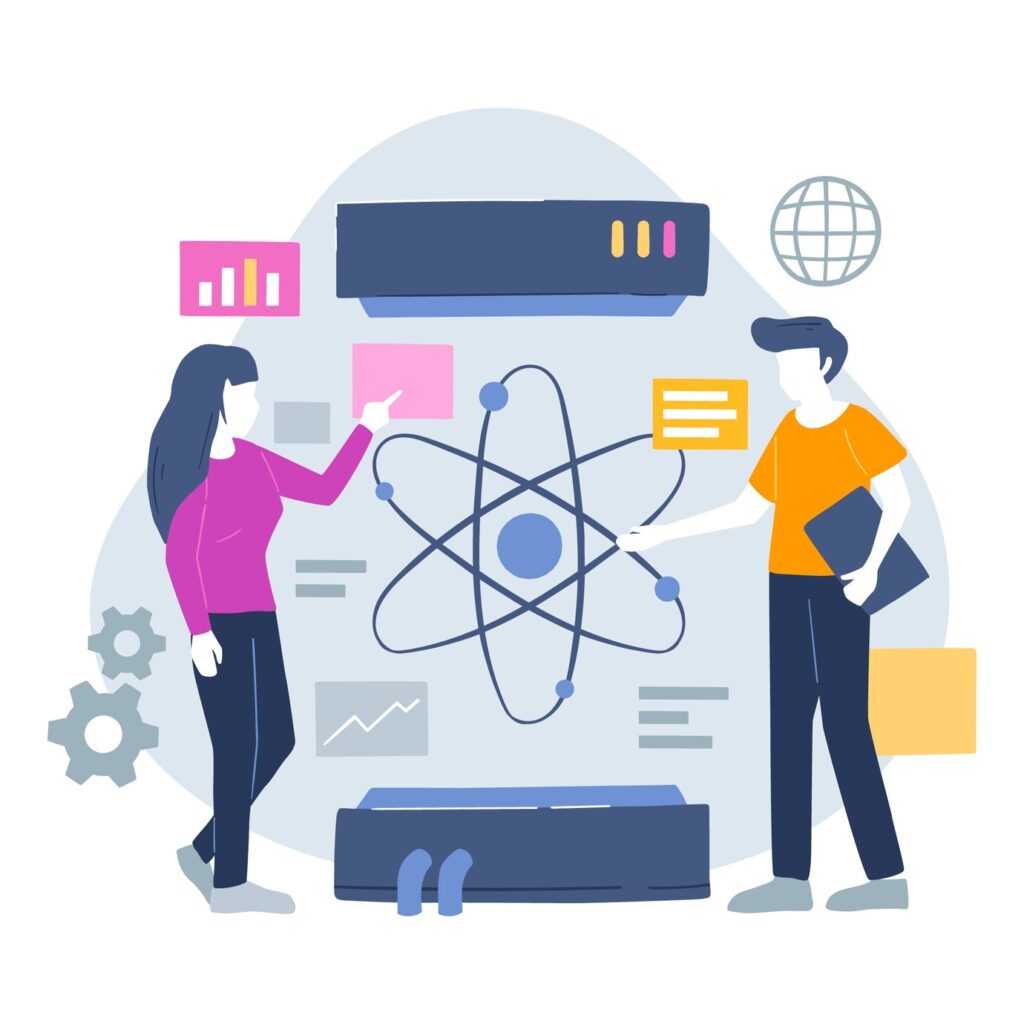Python has become the go-to language for machine learning (ML) due to its simplicity, flexibility, and vast ecosystem of libraries. Its clear syntax and readability allow developers to focus on solving ML problems rather than managing code complexities.
Python libraries play a crucial role in simplifying ML development by providing pre-built functions, tools, and frameworks. These libraries handle tasks such as numerical computations, data manipulation, visualization, and model training, saving developers time and effort.
Some of the most popular Python libraries for machine learning include NumPy for numerical operations, Pandas for data manipulation, Matplotlib for data visualization, Scikit-Learn for comprehensive ML tasks, TensorFlow and PyTorch for deep learning, among others. Each library offers unique functionalities, making Python a versatile language for developing and deploying ML models across various domains, from finance and healthcare to robotics and natural language processing.
What is a Python Library in Machine Learning?
A Python library is a collection of pre-built functions, modules, and tools that simplify coding tasks, especially in complex fields like machine learning (ML). These libraries provide ready-to-use implementations of algorithms, data processing techniques, and visualization tools, eliminating the need to write code from scratch.
In machine learning, Python libraries play a vital role by offering efficient solutions for tasks such as data preprocessing, model training, evaluation, and deployment. Libraries like Scikit-Learn, TensorFlow, and PyTorch provide comprehensive frameworks for developing ML models, handling everything from basic algorithms to advanced deep learning architectures.
The benefits of using libraries in ML projects include faster development, reduced errors, and access to optimized algorithms. Developers can leverage well-tested code, focus on model innovation, and streamline workflows, making Python libraries essential for building reliable and scalable machine learning solutions efficiently.
Top Python Libraries for Machine Learning
1. NumPy
NumPy is the foundation of numerical computations in Python, making it indispensable for machine learning projects. It provides support for multi-dimensional arrays and matrices, along with a collection of mathematical functions to operate on these data structures efficiently.
Key features of NumPy include:
- ndarray: A powerful n-dimensional array object for storing and manipulating large datasets.
- Broadcasting: Performing operations on arrays of different shapes without manual alignment.
- Linear algebra operations: Matrix multiplication, eigenvalues, and singular value decomposition.
- Random number generation: Essential for initializing weights in machine learning models.
- Integration with other libraries: Libraries like Pandas, SciPy, and TensorFlow rely heavily on NumPy for data handling.
NumPy’s seamless integration with other ML libraries enhances its versatility. It also optimizes performance by executing operations close to hardware using vectorization, making large-scale computations faster.
Use cases include:
- Data manipulation and cleaning during preprocessing.
- Feature scaling and normalization using NumPy’s statistical functions.
- Matrix operations in algorithms like linear regression and neural networks.
Example:
import numpy as np
arr = np.array([1, 2, 3])
print(arr + 10) # Output: [11 12 13]2. Pandas
Pandas simplifies data manipulation and analysis, making it a go-to library for handling structured data in ML projects. It provides DataFrames, which allow intuitive data manipulation similar to spreadsheets or SQL tables.
Key features of Pandas include:
- DataFrames and Series: Two primary data structures for handling labeled and indexed data.
- Data Cleaning: Functions for handling missing values, duplicates, and data transformations.
- File Handling: Reading from and writing to formats like CSV, Excel, and SQL databases.
- GroupBy Operations: Aggregating data based on specific conditions.
- Time Series Analysis: Built-in support for time-indexed data.
Pandas is essential for preprocessing ML datasets, enabling data exploration, transformation, and cleaning, which are critical steps before model training.
Use cases include:
- Merging and joining datasets from multiple sources.
- Feature engineering such as creating new features from existing data.
- Exploratory Data Analysis (EDA) to uncover patterns and insights.
Example:
import pandas as pd
df = pd.read_csv('data.csv')
print(df.head())3. Matplotlib
Matplotlib is a versatile library for data visualization in machine learning, offering a wide range of plotting functions to explore and present data effectively.
Key features of Matplotlib include:
- Basic Plots: Line graphs, bar charts, histograms, and scatter plots.
- Customization: Control over plot elements like labels, legends, and colors.
- 3D Plotting: Visualizing data in three dimensions for better insights.
- Interactive Plots: Enabling dynamic visualizations with tools like mpl_toolkits.
- Subplots: Creating multiple plots within a single figure.
Visualization is crucial in ML for understanding dataset distributions, evaluating model performance, and presenting results.
Use cases include:
- Visualizing data distributions to identify outliers.
- Plotting learning curves to monitor training and validation performance.
- Confusion matrices for classification model evaluation.
Example:
import matplotlib.pyplot as plt
plt.plot([1, 2, 3], [4, 5, 6])
plt.show()4. SciPy
SciPy builds on NumPy by providing additional functionality for scientific and technical computing. It is widely used in ML for tasks like optimization, integration, and signal processing.
Key features of SciPy include:
- Optimization: Algorithms for minimizing functions and fitting models.
- Integration: Numerical integration methods for complex equations.
- Signal Processing: Tools for filtering, transformation, and spectral analysis of signals.
- Statistical Functions: Probability distributions, hypothesis tests, and statistical tests.
- Sparse Matrices: Efficient storage and operations on sparse datasets.
SciPy’s vast collection of algorithms and functions makes it indispensable for mathematical operations that underpin machine learning algorithms.
Use cases include:
- Hyperparameter optimization using SciPy’s optimization functions.
- Feature scaling with statistical methods.
- Data interpolation for handling missing values.
Example:
from scipy import optimize
result = optimize.minimize(lambda x: x**2, 0)
print(result)5. Scikit-Learn
Scikit-Learn is the most popular library for classical machine learning algorithms. It offers tools for classification, regression, clustering, and dimensionality reduction, making it a comprehensive solution for ML tasks.
Key features of Scikit-Learn include:
- Preprocessing: Standardization, normalization, and data transformation utilities.
- Model Selection: Cross-validation, grid search, and hyperparameter tuning.
- Ensemble Methods: Random forests, gradient boosting, and bagging algorithms.
- Feature Selection: Identifying the most relevant features for model training.
- Metrics: Functions to evaluate model performance such as accuracy, precision, and recall.
Scikit-Learn’s intuitive API and extensive documentation make it ideal for beginners and experienced ML practitioners alike.
Use cases include:
- Building classification models such as SVMs and logistic regression.
- Clustering analysis with K-means and DBSCAN.
- Dimensionality reduction using PCA and t-SNE.
Example:
from sklearn.ensemble import RandomForestClassifier
clf = RandomForestClassifier()
clf.fit(X_train, y_train)6. Theano
Theano is designed for numerical computation, particularly efficient computation on GPUs, which is crucial for deep learning models. It allows users to define, optimize, and evaluate complex mathematical expressions.
Key features of Theano include:
- Symbolic Computation: Defining mathematical operations symbolically for optimization.
- GPU Support: Accelerating computations using GPU capabilities.
- Automatic Differentiation: Essential for training neural networks through backpropagation.
- Custom Operations: Allowing users to define their own mathematical operations.
- Integration with Keras: Theano serves as a backend for Keras models.
Although newer libraries like TensorFlow and PyTorch have gained popularity, Theano laid the groundwork for modern deep learning frameworks.
Use cases include:
- Defining deep learning models with symbolic operations.
- Optimizing complex mathematical functions in ML algorithms.
- GPU-accelerated computations for large datasets.
Example:
import theano
x = theano.tensor.dscalar('x')
y = x ** 2
f = theano.function([x], y)
print(f(3)) # Output: 9.07. TensorFlow
TensorFlow, developed by Google, is an end-to-end platform for building and deploying machine learning models, especially deep learning models.
Key features of TensorFlow include:
- Tensor Operations: Efficient manipulation of multi-dimensional arrays (tensors).
- Keras Integration: High-level API for easy model building.
- Deployment Tools: TensorFlow Serving for deploying models at scale.
- TensorBoard: A visualization toolkit for monitoring model training.
- TensorFlow Lite: Deploying models on mobile and edge devices.
TensorFlow’s extensive ecosystem supports tasks ranging from research to production, making it highly versatile for ML practitioners.
Use cases include:
- Building deep neural networks for image and speech recognition.
- Deploying ML models in cloud, mobile, and edge environments.
- Training large-scale models with distributed computing.
Example:
import tensorflow as tf
model = tf.keras.Sequential([...])
model.compile(optimizer='adam', loss='mse')8. Keras
Keras is a high-level neural networks API built on top of TensorFlow, designed for rapid prototyping and easy model development.
Key features of Keras include:
- Modular Architecture: Easy to build and modify neural networks.
- Predefined Layers: Layers like Dense, Conv2D, and LSTM for deep learning.
- Built-in Training Tools: Loss functions, optimizers, and evaluation metrics.
- Support for Multiple Backends: TensorFlow, Theano, and CNTK.
- Transfer Learning: Reusing pre-trained models for new tasks.
Keras simplifies the deep learning process, making it accessible to beginners and efficient for experienced developers.
Use cases include:
- Rapid prototyping of deep learning models.
- Transfer learning for fine-tuning pre-trained models.
- Building complex neural networks with minimal code.
Example:
from keras.models import Sequential
model = Sequential([...])
model.compile(loss='binary_crossentropy', optimizer='adam')9. PyTorch
PyTorch, developed by Facebook, is a dynamic deep learning framework known for its ease of use and flexibility in research.
Key features of PyTorch include:
- Dynamic Computation Graphs: Build and modify neural networks on the fly.
- TorchScript: Transition from research to production seamlessly.
- Rich Ecosystem: Libraries like TorchVision and TorchText for specific ML tasks.
- Autograd: Automatic differentiation for gradient computation.
- ONNX Support: Exporting models to the Open Neural Network Exchange format for interoperability.
PyTorch’s user-friendly interface and strong community support make it a preferred choice for researchers and developers.
Use cases include:
- Developing deep learning models with flexible architectures.
- Conducting cutting-edge research in AI and ML.
- Deploying models using PyTorch’s production tools.
Example:
import torch
model = torch.nn.Sequential([...])
loss_fn = torch.nn.MSELoss()Conclusion
The Python libraries for machine learning discussed—such as NumPy, Pandas, Matplotlib, SciPy, Scikit-Learn, Theano, TensorFlow, Keras, and PyTorch—form the backbone of modern ML development. Each library offers unique capabilities, from numerical computations and data manipulation to deep learning model building and deployment.
Selecting the right library is crucial for optimizing performance, efficiency, and scalability in ML projects. Whether working on data preprocessing, model training, or visualization, these libraries provide robust tools for every stage. Exploring these libraries equips developers with the essential resources to build, refine, and deploy innovative ML solutions effectively.


